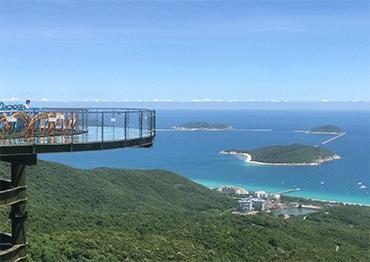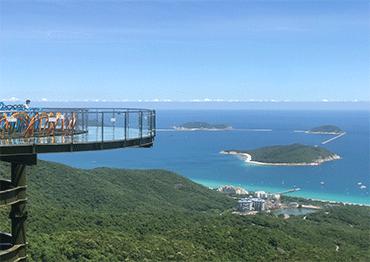There are many reasons why tourists visit China. International travelers are drawn to the fascinating history and breathtaking historical landmarks, including the Great Wall and the Terracotta Warriors. Others come to cruise the gorges of the Yangtze River, or marvel at sleepy pandas in bamboo forests. However, it might surprise people to know that China also has a lot to offer thrill-seeking visitors who enjoy filling their spare time with rather more extreme and unusual activities. Whether they enjoy rock climbing, skydiving or scuba-diving, China offers countless opportunities for adrenaline junkies to get their fix.
For visitors who enjoy heights, China offers countless exciting places to visit. Given the abundance of skyscrapers in China, it should not be so surprising that many cities offer visitors activities that are guaranteed to terrify any acrophobe. Destinations including the Oriental Pearl Tower in Shanghai, Canton Tower in Guangzhou, and the Shanghai World Financial Center, allow visitors to stand on transparent glass floors, hundreds of meters above the ground.
These glass floors typically jut out from their tower, ensuring that any brave souls standing on them see nothing below their feet other than the distant ground. Moreover, as if such platforms were not terrifying enough, visitors to the Canton Tower can also travel around the edge of the skyscraper in a “bubble car” or experience freefall from almost 500 meters on the tower’s thrilling Sky Drop ride. Yet even these activities are nothing compared to the open-air glass skywalk at the Jinmao Tower in Shanghai. This external 60-meter glass walkway is a terrifying 340 meters above the ground, and yet has no handrails. Daredevils are free (while harnessed to an overhead rail) to sit on the edge of the walkway or lean right out over the city below. Likewise, Macao Tower offers a similar external, handrail free, skywalk. While this skywalk may only be 233 meters in the air, this icon of the Macao skyline also offers visitors the chance to bungee jump from near its summit.
The views from these destinations are stunning and allow tourists to witness the immense scope and scale of these global cities. But if the idea of standing on a glass floor in a tower sounds terrifying, imagine walking along an entire glass floored bridge above a jagged canyon. This jaw-dropping concept is now a reality, and a popular feature, in numerous Chinese provinces. Yuanduan Skywalk in Chongqing’s Longgang National Geological Park is a mesmerizing 718 meters above ground. Meanwhile, Shiniuzhai National Geopark near Pingjiang in Hunan Province, Ruyi Peak Scenic Area near Yangshuo in Guangxi Zhuang Autonomous Region, and Tianmenshan National Forest Park near Zhangjiajie, also in Hunan, offer visitors the chance to walk along extended glass bottomed pathways, which snake along the side of sheer cliff edges. With only vertical rock above and below, visitors have no choice but to trek on toward eventual safety, all the time agonizing about whether they dare look down. However, perhaps the most fascinating of all glass walkways is the 536-meter-long, 6-meter-wide Yuntiandu Glass Bridge near Zhangjiajie. This bridge spans a deep valley, and its sheer scale has ensured that it has set multiple world records. Other similar attractions around China include the Ruyi Glass Bridge in Shenxianju Scenic Area, the Qingyuan Yuntian Boba Glass Bridge, and the Qingchuan Glass Bridge in Huangchuan Three Gorges Scenic Area.
For those who can’t stomach heights but still seek an adrenalin rush, there are plenty of alternative activities. China is home to numerous rivers, where visitors can experience whitewater rafting. Many of the opportunities available in China are technically drifting rather than rafting, in that participants do not row or paddle down the river. Instead, the current carries them down river and they follow its course at the will and whim of nature. Excellent examples of drifting can be found in Yangshuo Xingping Longjing River, Guangxi Zhuang Autonomous Region, Wangzigu drifting adventure in Chun’an County, Zhejiang Province and Gulong Canyon near Qingyuan, Guangdong Province. While the idea of drifting may sound rather relaxing, participants should be aware that many of these rivers are boisterous to say the least. The protective clothing visitors are required to wear is extremely important. Needless to say, after being thrashed around in wild rapids for a number of hours, participants will be grateful to come away without too much bruising.
For those who want to get even wetter, China also offers opportunities for snorkeling, scuba diving and a wide variety of water sports. While scuba divers typically explore the waters off the tropical beaches of Sanya’s Wuzhizhou Island, Zhuhai’s Wanshan Island, and Hong Kong’s Sharp Island, China also offers some rather more peculiar and unique diving opportunities. For example, Qianxi, near Tangshan in Hebei Province, is home to the Underwater Great Wall, where an ancient walled city reveals itself to adventurous divers 20 meters below the surface. Alternatively, nature lovers might be interested in diving Jellyfish Lake in Beijing’s Fangshan District. As the lake’s name suggests, this dive offers visitors the opportunity to see freshwater jellyfish which are known to periodically bloom in such numbers that people refer to them as a “jellyfish storm.”
Meanwhile, for those who lust after speed, China’s beaches have plenty to offer. Whether visiting Sanya, Qingdao, or Huizhou, it is common to find jet skiing, banana boat rides, parasailing, water skiing and windsurfing. These activities can often be purchased directly from vendors on the beaches. However, many groups choose to charter a cruise boat for a few hours, head further from shore, and claim their own area of ocean in which to swim, jet ski and fish to their heart’s content. However, travelers do not need to visit a beach to experience wild water sports. One of the biggest watersport crazes to become popular in China in recent years, flyboarding, is often offered in lakes and reservoirs as well as by the ocean. In assorted bodies of water across the country, including in Nanning, Dongguan, and Hangzhou, brave people find themselves hydroflying up to 20 meters in the air, often followed by a headfirst speed-dive into the murky depths below. Moreover, while hydroflying may be a one-off experience for many people, there are increasing numbers of people who use hydroffight hoverboards and jetpacks within competitive events. Accordingly, hydroflying can be as exciting to watch as to partake in.
With so many exciting adventures in cities and scenic areas across China, it is no wonder that increasing numbers of visitors are choosing to try different activities when they explore China. Go beyond the Great Wall and the Forbidden City, and who knows what excitements lie in wait.

 Old Version
Old Version
